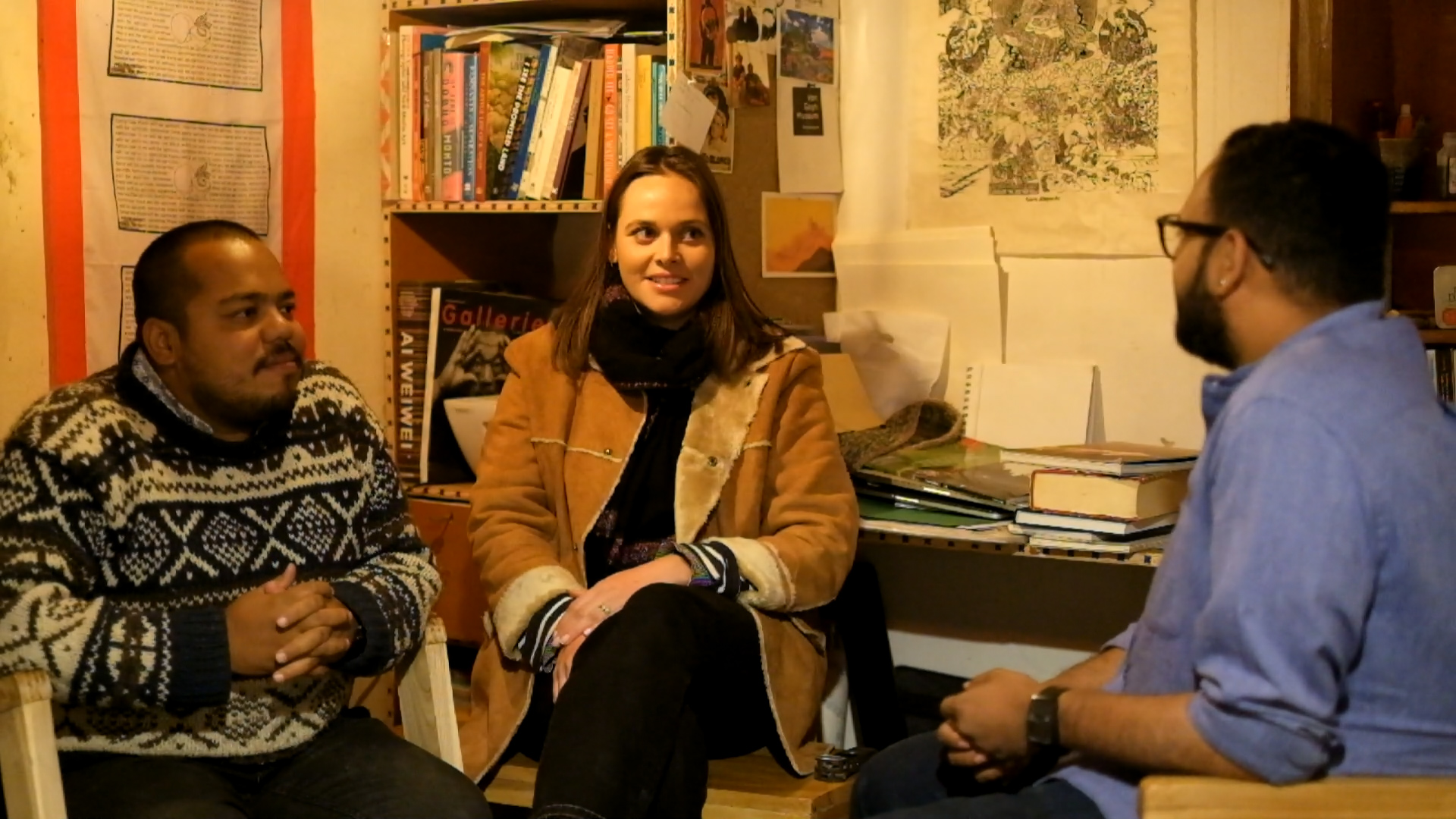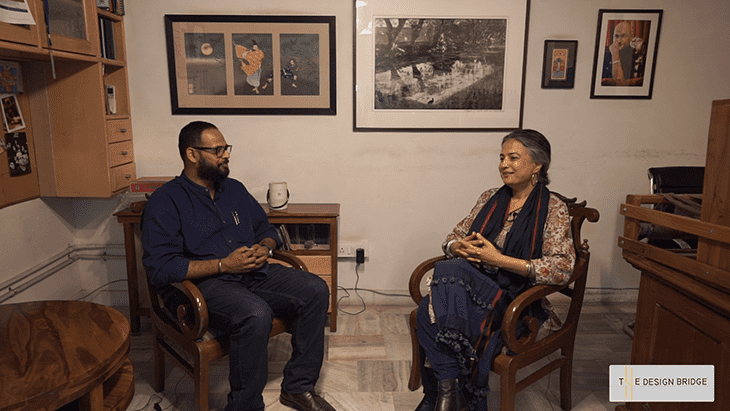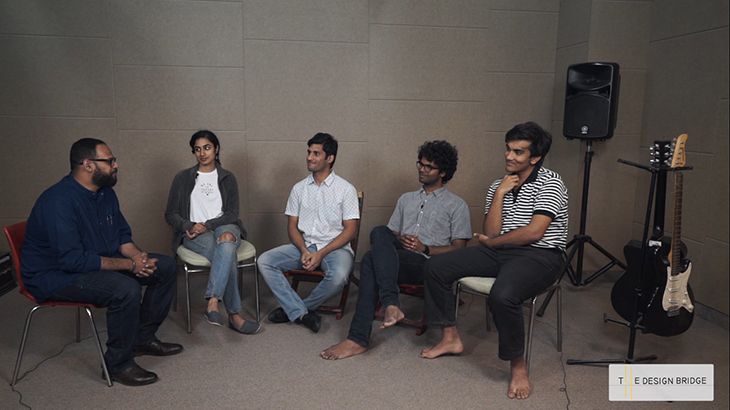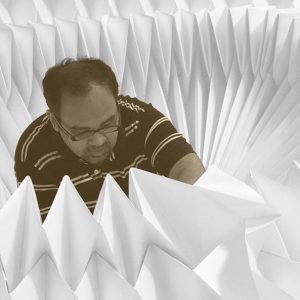
PROFILE
- Ankon Mitra is an architect, landscape designer and pioneer of Origami, Kirigami and folding techniques in India. He has a post- graduate degree from the Bartlett, University College London. Since 2007, he has been Director (Landscape and Art Installations) at Hexagramm Design Pvt. Ltd., based in New Delhi, India.
- Through the initiative - Oritecture, his Studio has taken the art and craft of Origami to materials well beyond paper. Materials such as sheet copper, brass, fabric, leather, polypropylene, stone, wood veneer, concrete and ceramics all form a part of his Studio’s oeuvre.
- He is a recipient of the All-India Gold Medal for Sculpture in 2018. He has shown his work at exhibitions in India, Italy, U.K and Singapore, most recently at the Lucca Biennale in Italy, where he won the outdoor art award for his installation - the Sights and Sounds of the Cosmos.
- He counts among his clientele the current Finance Minister of India, Toyota Lexus, the APL Apollo Group, Hotel St. Regis and the Emami Foundation.
- Ankon passionately believes that the universe is made and unmade from acts of folding and unfolding. He has a five year old son who loves crumpling and creasing paper.
ARTICLE
- The universe is emergent from acts of folding and unfolding. All energy waves (sound, light, heat) travel by folding through space. Einstein proved that empty space itself is crumpled and folded due to the gravitational force of massive star systems, galaxies and black holes. Human life (and indeed all life forms on this planet) start their journey when RNA and DNA fold into precise sequences, interlocking within strands to form healthy cells which develop into babies. The correct folding sequence is crucial to the making of life. The micro structure of all materials (metals, crystalline structures, water, gas) is determined by the folding and interlocking structures of constituent atoms and molecules. When a folding sequence changes, ice melts into water and evaporates as vapour.
- The spaces in which these cosmic, micro-biological and sub-atomic phenomenon occur, cannot be comprehended by our five senses. Even when we peer through telescopes and microscopes, to understand the nature and scale of these spaces is far from easy. We can only guess at their complexity, their geometric calisthenics, their meaning.

Flare,Worm and Spiral, Source-Author
- Every day I am amazed by humanity’s obsession with itself. Why are we so extraordinarily self obsessed, so naricissistic, so self involved, self-conscious? Why are human affairs so important?
- Our hates, our loves, our politics, our religions, our cultural practices and beliefs, the human body, our festivals, our diseases and our wars, our hopes and our relationships - even subsume our lives in following human affairs. Even when we think of the Earth and its billion other species, the cosmos, it is always in relationship to us, and our place in this vastness. A natural and very disappointing corollary of this is that architects are only trained to think of space in limited and limiting human-centric ways.
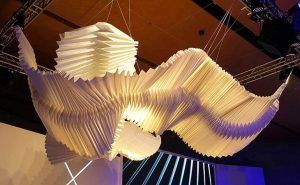
Fluid Flight, Source-Author
- As a species, inspite of our tremendous brain power, thinking and analytical abilities, we are unable to transcend the human condition. We mostly talk about other human beings to each other, 99% of our news is about human activities of one sort or another, we rise and fall through our entire lives through an array of human emotions, and we do little else other than drowning our thoughts and our actions in the humdrum of human affairs.
- Thus, architecture too has failed, because it could explored the spatial magnificence of the universe and the wondrous magical spaces in nature - in which a singular act is often far more momentous and consequential, than all acts of all humans through history - put together. Our ceaseless and foolish chatter could thus pale into rightful insignificance, by the sheer majesty of truths much larger than our limited realities, the wonderment of spatial contortions and transformations we can only imagine in our mind's eye. We would thus make a beginning of moving away from the vanity of spaces stifled by gravity, by ergonomics, by structural limitations, by walls, doors and windows. Our spaces are limited by our bodies, by the fact that we cannot walk up walls, that we cannot sleep standing, that we need sunlight and oxygen, that we have to protect ourselves from rain. What if we could break these shackles while thinking about space? In the Universe, or inside an atom, space has no such limitations imposed by human beings. It is a promise of space unshackled from human restrictions, free from the tyranny of human-centric architecture.

The Sights and Sounds of the Cosmos, Source-Author
- Folding as an act, and as a technique, shows me a glimmer of that promise, that spatial freedom, borne out of non-Euclidean geometry and out of mathematics, ever present in the physics and in the spirit of the universe, eternal, ever-radiant and untainted by humanity. It is also my personal shot at salvation, to peek inside the working of a carbon atom, or the pulsating nature of a comet as it travels through the solar system, careening past the sun and outwards again. Through these imaginations of other spaces, we could come closer to understanding many workings of the world where humans play no part. How do the land and the sea wage war with each other to fashion coastlines of continents? How did the Himalayas come into being through the shifting of tectonic plates? How are there thousands of kilometres of rainforests right next to thousands of kilometres of desert – enmeshed into each other in the continent of Africa, one ending and the other starting most inexplicably? How does the planet Earth, within the Solar System, within the Orion arm of the Milky Way, hurtle through space at a speed of 2.1 million kilometres per hour, yet I sit at my desk writing out this impassioned plea in near perfect stillness? Yes. We hurtle through space at that mind-bending speed at all times throughout our lives (even while sleeping soundly in our beds)!

Meditation on a Nebula, Source-Author
- If the thought of a reality like this one does not arouse the architect’s imagination to a feverish pitch of spatial swashbuckle, I do not know what can. What happens to space at the event horizon of a black hole, for instance? If we are to truly transcend, we have to step away from a human-centric view of the world, and look at other spaces. Biomimicry makes a limited beginning - by studying ant colonies, coral reefs, bee-hives and so on. But even in this, we study only with the aim of adapting knowledge of other spaces to human habitat, to benefit humanity. This means that we do not open our minds-up enough. We shackle our intellect and our potential. These chains are of our own making. The eternal but awaits a-knocking. In these other spaces lie hidden away, our true other-selves, where mind and matter meld together. The shapes and forms of energy can be seen, but not with our eyes, because in these other spaces, our understanding of spatiality is no longer limited by our five senses.

Walking Upside Down near a Worm Hole Portal, Source-Author


